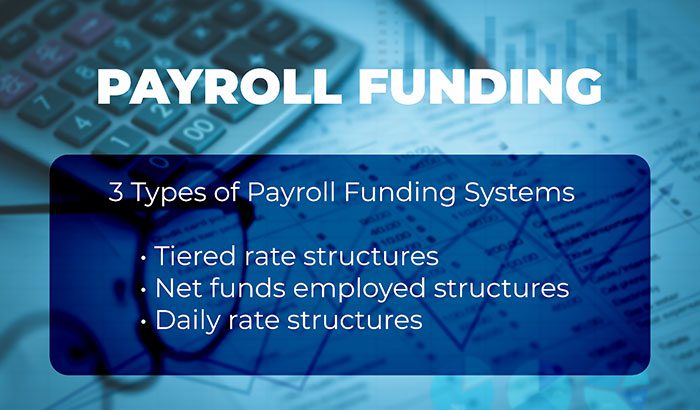Consider payroll funding if your business is booming and payday is approaching, but unpaid invoices prevent you from making payroll. This form of capital allows you to keep your operation running smoothly despite delays.
As a business owner, you might not know what to expect in every situation. Unexpected things can affect how your business operates, but one thing always stays the same: your employees must be paid on time.
Keep reading to learn more about payroll funding, including how it works, how much it costs, and more.
What Is Payroll Funding?
Before we dive into how much payroll funding costs, let’s look at exactly how payroll funding works.
Payroll funding allows you to sell your invoices for cash with the intent that you’ll use that cash for your payroll needs. In addition, payroll funding gives you capital to work with while waiting for your clients to pay their invoices.
With payroll funding, you can avoid factoring, where you sell off outstanding accounts, and invoice discounting, where you use your invoices as collateral.
How Does Payroll Funding Work?
For such a helpful process, you might perceive it as a complicated process. But it’s relatively easy to obtain payroll funding.
There are several steps involved. First, you send out invoices for the services you’ve provided. Next, while waiting for client payments, you’ll sell your accounts receivable (unpaid invoices) to a payroll funding company.
Third, that company will give you up to 90% of the money that the invoices are worth. They’ll hold back about 10% as collateral. Once you’ve received the client payments that go with those invoices, you’ll pay back the advance you received from the payroll funding company. The company will return the 10% collateral minus their fee at that time.
That’s how payroll funding works in a nutshell.
How Much Does Payroll Funding Cost?
So, you’re probably wondering about that fee we just mentioned. Payroll services charge a small fee for funding. However, besides that fee, there are no hidden charges.
How much payroll funding costs depends on the funding rate structure of the company with whom you’re working. There are three funding structures that most payroll funding companies use. The cost also depends on how much funding you need. Naturally, you’d pay more for $100,000 in payroll services than $10,000.
1. Tiered rate structures are the most popular form of payroll funding.
The discount rate or fee that the staffing company charges you increases over time. So, the longer it takes for your clients to pay their invoices, the higher the fee you’ll pay.
Tiered rate structures usually work in 15-day increments, increasing every 15 days. For example, say you have a $10,000 invoice from a client who pays it in 31 days.
For the first 15 days, you pay 0.50% of the invoice. You pay 1.50% from days 16 to 30 and 2.50% from days 31 to 45. Since the invoice is paid on day 31, you’ll pay 2.50% of the $10,000, or $250.
Because of how tiered rate structures work, it gets more expensive the longer it takes a client to pay an invoice. For this reason, many small businesses charge late fees if invoices aren’t paid by a specific date since it costs them more money to operate with overdue invoices.
2. Net funds employed structures are best for predictable situations where you always need around the same amount of funding.
However, this type of payroll funding is slightly more complicated, deterring some companies from seeking it out.
There’s the interest rate and the service (or transaction) fee. The interest rate is usually a percentage of the payroll funding and LIBOR. The service fee is a flat fee applied to each invoice that ranges between 0.75% and 1.5% of the invoice’s face value.
The interest and service fees accrue every month. Generally speaking, you’ll pay these fees at the end of the month. For example, for a $10,000 invoice with a 2% interest rate, 5% per annum, and a 1.0% service fee, you’d pay $159.45 for an invoice paid on day 31.
Even though it’s slightly more complicated than a tiered rate structure, the net funds employed structure is much less expensive.
3. Daily rate structures work by having a daily rate multiplied by every day the invoice is outstanding.
Say that the $10,000 invoice is paid on day 31 with a 0.07% daily rate. It would cost $217 for this payroll funding.
When choosing a payroll funding company, be sure to find out how their funding works. If you have a few options, it’s worth calculating how much you’ll pay. It’s also a good idea to check the reviews for the funding company. The cheapest company might not be the best choice in every case. Exceptional customer service with a fair price is what’s most important.
What are the Advantages of Payroll Funding?
Payroll funding can be a game changer, especially if you have clients who pay their invoices after you process payroll. Several advantages of payroll funding include the following:
- No cash flow issues
- Same-day payroll funding
- No hidden fees
- Payroll processor of your choice
- Allows you to grow your business
- Easy to access
- No added debt
- Flexibility
What Industries Use Payroll Funding?
Regardless of what industry you work in, payroll funding can help you. Many small businesses and start-ups use payroll funding, but it also works for staffing companies, janitorial, retail, utility, financial services, government, education, and B2B services.
Lighthouse Financial Can Help.
Lighthouse Financial offers payroll services to businesses like yours, and applying doesn’t affect your credit score. Our simple process makes it easy to access the funding you need to keep your business running smoothly, even when clients take a while to pay their invoices.
Apply now on our website, or call us at 888.418.1288 to get started with your payroll funding today. Let Lighthouse Financial be there for you.

